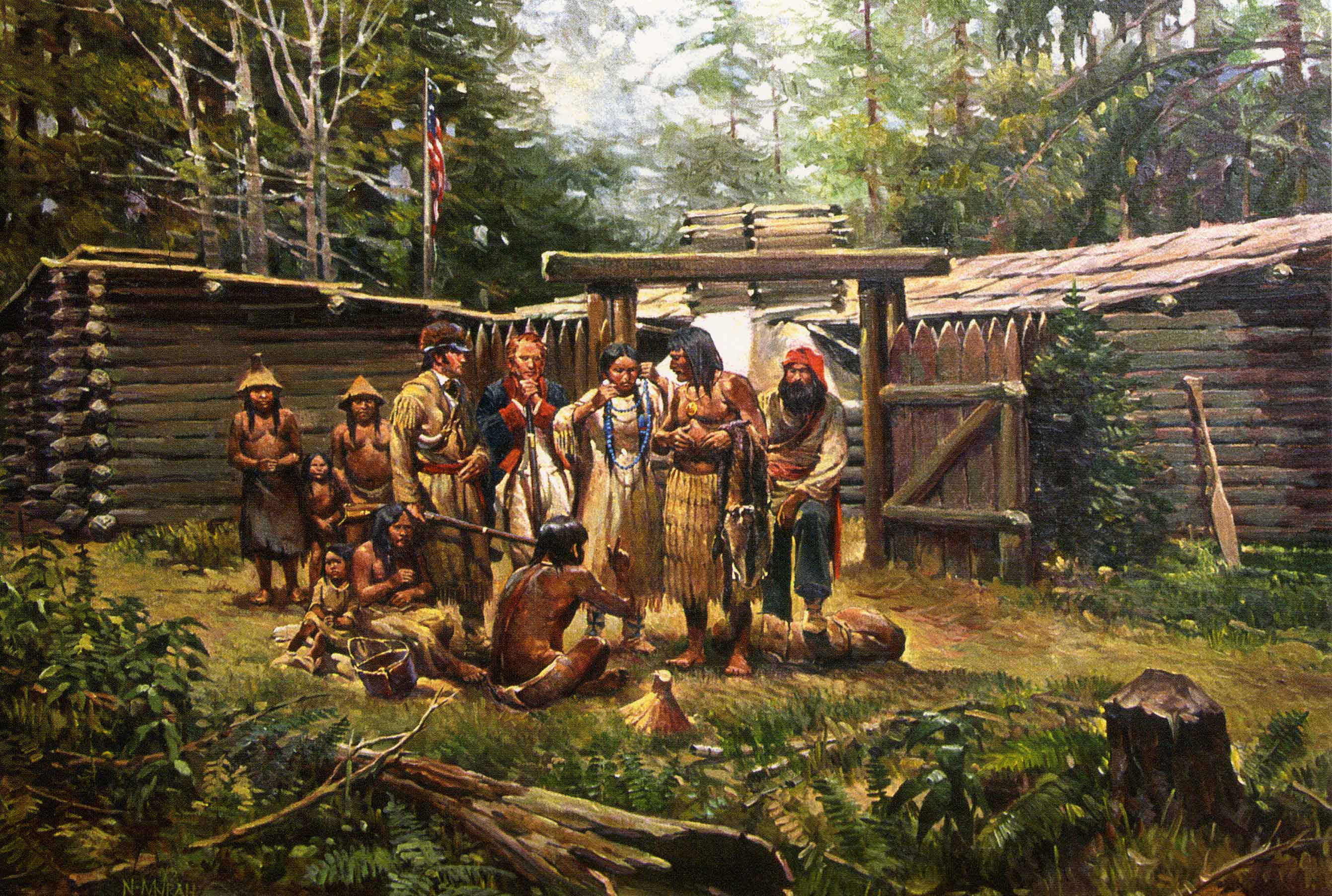
(The above image is public domain sourced from Wikimedia Commons.)
Beginning
In 1803, President Thomas Jefferson proposed a expedition to the Pacific Northwest, exploring the Louisiana Territory (which had just been purchased from France for $15 million) and the land beyond it. Congress approved the idea, and 28-year-old Meriwether Lewis was chosen to lead the “Corp of Discovery” as it was called. Lewis, however, wanted a reliable partner to travel with him on this great journey. Who else but William Clark? Lewis wrote to his friend in June 1803, and one month later, Clark wrote back agreeing to accompany him on the expedition. Clark, however, was commissioned as a lieutenant while Lewis was a captain. Wishing to share equal authority during the expedition, Lewis and Clark withheld this fact from the men.
Departure from Camp Dubois
The Corp of Discovery departed Camp Dubois (located near present-day Wood River, Illinois) at 4 PM on May 14, 1804. Lewis was in St. Louis at the time, so the men waited at St. Charles for him to join them. They had an 8,000 mile journey ahead of them – one that no white man had ever attempted. The journey up the Missouri River was a hard one. If the wind was right, the sails were of some help, but for the most part, the men had to row, push, and pull the heavy-laden keelboat against the strong current.
Lost Along the Missouri
On August 26, 1804, while retrieving two pack horses, Private George Shannon, the youngest member of the expedition, was separated from the rest of the men. For twelve days, he went without food. He was able to survive on wild grapes and rabbit until the expedition found him starving on the banks of the Missouri sixteen days after he went missing. (Shannon lost his way again on August 6, almost a year later, while scouting upriver. This time, however, he was able to rejoin the expedition in only three days.)
Pompey
Jean Baptiste Charbonneau was born on February 11, 1805. His mother was the famous Shoshone guide and interpreter, Sacagawea, and his father a French trapper, Toussaint Charbonneau, who also served as guide and interpreter. Clark nicknamed the boy “Pompey” and later raised him at his own home in St. Louis, sending him to St. Louis Academy for an education. As an adult, Jean Baptiste traveled for nearly six years with Duke Friedrich Paul Wilhelm of Württemberg and went on to become a hunter, trapper, gold miner, etc.
The Long Detour
Upon coming to an unexpected fork in the river, a vote was taken on which route was the Missouri River. Lewis and Clark were the only two to vote on the southern fork. Another vote was taken with the same results. The men finally agreed with their leaders and took the southern route. A scouting party led by Lewis discovered the Great Falls of the Missouri confirming that they had taken the correct fork. The treacherous, eighteen-mile detour around the falls, however, took a month and a half to complete.
An Unexpected Reunion
While Clark was gone on a scouting mission, Lewis met sixty Shoshone warriors. He was able to gain trust in the Shoshone camp by handing his rifle to the chief. Sacagawea recognized the chief. He was Cameahwait – her brother. Clark rejoined them, and with Sacagawea’s help, they negotiated with the Shoshones for the horses needed for crossing the mountains yet ahead.
Illness
After crossing the Bitterroot Mountains, the expedition found help from the Nez Perce Indians. After days of starving while crossing the mountains, all of the men fell ill from overeating the dried fish and boiled roots provided by the Indians. They stayed with the Nez Perce for two weeks, hewing canoes, before heading on for the final stretch of the voyage to the Pacific.
Estuary of the Columbus River
On November 7, 1805, Clark recorded viewing the Pacific Ocean. It was, in fact, the Columbia River’s estuary – not the Ocean. They were still twenty mile from reaching the Pacific. While on the estuary, the waves became too dangerous for the canoes, and they were force to set up camp. They made another attempt, clinging close to the shoreline, but the conditions were still too hazardous to continue. A violent thunderstorm with hail, high winds, and heavy rain attacked them next. They had to bury their canoes under rocks and retreat inland to wait out the storm. Once the storm finally relented, they were able to cross the estuary and reach the Pacific Ocean. They had reached their goal! The return voyage was all that remained.
Voting
Upon reaching the Pacific, the expedition spent the next ten days hunting, trading with the Chinook and Clatsop Indians, and exploring the surrounding area. A vote was finally taken on where they should camp for the coming winter. Sacagawea and York, Clark’s slave, both participated in the vote. It is the first recorded time of woman or a black ever voting. Following the recommendations of the local Indians, they set up camp on the Oregon side of the river. Fort Clatsop – a log fortress – was completed on December 30, 1805, and the men settled in for what proved to be a miserable winter. Of the three months they stayed there, only twelve days were without rain.
The Long Voyage Home
On March 23, 1806, the expedition left Fort Clatsop finally beginning their long journey home. Mountain snows delayed their travels, however, and they had to camp with the Nez Perce Indians for a month before continuing the journey. With the help of three Nez Perce guides, they were able to cut 300 miles off of their route.
On July 3, the expedition split into two groups to better explore the area – Clark leading one party, and Lewis the other. On July 25, Clark named a rock formation on the Yellowstone River “Pompey’s Pillar” after Sacagawea’s son. He inscribed his name and date on the rock. This inscription is the only remaining physical evidence of the expedition. The next day, Lewis and his men came upon several Blackfeet warriors. The Indians seemed friendly, so the men spent the night with them. Two of the braves were killed the next morning while trying to steal the men’s guns and horses. Hoping to escape revenge from the Indians, the men rode for nearly 24 hours without stopping.
After leaving Sacagawea and her nineteen-month-old son with the Mandan Indians, the men continued down the Missouri River. With the current in their favor this time, they traveled over 70 miles a day.
Home At Last
On September 23, 1806, the men finally arrived in St. Louis having completed an 8,000 mile journey in two years, four months, and ten days. Moreover, of the forty five expedition members, only one did not survive. Sergeant Charles Floyd died, most likely from a ruptured appendix, on August 20, 1804 – only three months after they had first set out. They buried him with full military honors on a bluff overlooking the Missouri River.
Conclusion
At the time, the Corp of Discovery had accomplished what few had dreamed even possible. They had traveled more than 8,000 miles through unknown territory in less than two and a half years and only lost one man. They had met with hunger, cold, fatigue, illness, hostile natives, and unforeseen perils, but through it all, they had persevered. Lewis and Clark not only completed one of the greatest expeditions of all times, but they also brought back a wealth of information. Clark’s detailed maps of the West were the most accurate available until the 1840’s, while Lewis had discovered 174 plants and 134 animal species new to science.
Though they did not accomplish one of the original goals of finding an all-water route to the Pacific, Lewis and Clark made peaceful treaties with the Indians, drew up 140 of the most detailed Western maps of their time, and advanced science with hundreds of new plant and animal discoveries.

Recommended Sources:
- The Adventures of Lewis and Clark by John Bakeless
- “Lewis & Clark: Great Journey West” (2002) by National Geographic Television – running time: 45 min.
Note: While I do not support National Geographic, this documentary on the Lewis and Clark Expedition is excellent! The Making of Lewis & Clark is also an exciting behind-the-scenes film which contains historical tidbits not included in the final cuts of the documentary. (Warning: The Making of Lewis and Clark does contain two scenes with closeups of very-realistic ‘wounds’ by the makeup department.)
* * * * *
P.S. You can also follow me at my other blog, Kenmore Pines 1, here.
To learn more about this blog check out my blog launch post here.
